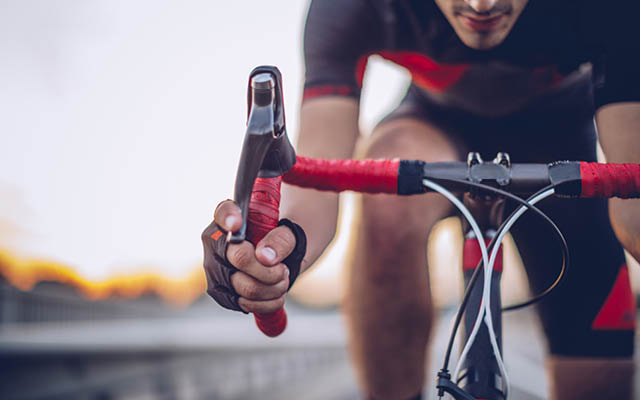“Tri (Harder)” is a series of posts by Kaelyn Riley, editorial coordinator and executive assistant to the founding editor for Experience Life. This series will document Kaelyn’s first-time experience training for the Life Time Triathlon.
Today marks 11 weeks since I officially started training for the Life Time Triathlon. So far, it’s been going really well. In the days after I registered, I worried over the potential for my motivation to flag as the weeks went on.
Sure, I was all jazzed up about my training program when I first started, but I figured the shine had to wear off eventually. I was pretty sure that, at some point, I’d quit adhering to my carefully color-coded training calendar. Some mornings, I’d probably hit the snooze button too many times, ZZZing away my chance at fitting in a workout.
Thankfully, though, this hasn’t been the case — at least, it mostly hasn’t. Sure, my week didn’t look exactly like the week I planned out almost three months ago on my (rather ambitious) training schedule. I’ve shaved off 10 minutes here, added a couple hundred yards there. And yesterday, when my alarm sounded at 6:30 a.m. and I felt my body gently requesting a rest day, I did skip the gym. Instead, I spent my extra morning hour stretching, sipping ginger tea, and reading a few of my favorite poems.
I guess it makes a certain amount of sense that the impending certainty of race day would keep me motivated. But honestly, I wasn’t expecting it to be so easy to keep going — and I definitely wasn’t expecting that the greatest difficulty of my training would be figuring out when to slow down.
I’m sure at least some of this is due to my training goals. My objective for this race has always been, simply, to finish. As a newcomer to the world of tri, it seemed like a mistake for me to set my sights on placing, or to aim to complete one or more legs in a predetermined amount of time. Those seem like lofty aspirations, more fitting for my third or fifth or eighth race, and I like a goal that I can see.
Fed Up With Fitspiration
Like anyone else with a somewhat active Pinterest account, I’ve noticed the site’s glut of “fitspo” — short for “fitspiration” — boards. I’ve seen at least some of the hundreds of images of tanned, chiseled, bikini-clad women, superimposed with lines like You Can Be Sore Tomorrow, or You Can Be Sorry Tomorrow; When You Start Seeing Results, It Becomes An Addiction; Banish Your Saddlebags for Good; Once You Control Your Mind, You Can Conquer Your Body.
I’m sure this sort of thing does work for some people, but it’s always made me feel a little sick to my stomach. At the very least, as fitness messaging goes, these are pretty misleading. (For more on “fitspo,” read “Real Bodies in a Virtual World.”)
Truth be told, if I’d ignored my body when I woke up yesterday — if I’d fought my way through some mileage on the bike instead of slowing down for my morning ritual — I’d probably be feeling sore and sorry today. I don’t want to become addicted to exercise (which is a real problem that probably shouldn’t be glorified). Don’t get me started on “saddlebags,” or any of the countless other denigrating terms we use to identify female body parts when they don’t look like they’re “supposed” to. My body is not a problem. I strive, whenever I can, to honor, nurture, and respect it. It’s not an obstacle. I don’t need to “conquer” it.
The truth is, it’s really hard to seek fitness advice in a world of clickbait and listicles. It’s even harder when we’re inundated with “inspiration” in the form of impossible body ideals, and messaging imploring us to “Never Miss A Monday” and to have “No Excuses.”
This is just one of many reasons that I feel lucky and proud to work at Experience Life, where our business is to empower our readers to realize their own healthy goals — realistically, on their own terms, and for the long haul.
Small Victories
Thankfully, I’ve never been convinced that I could reach my tri goal if I just, for instance, never missed a Monday. My training hasn’t given me a six-pack, or the oft-coveted thigh gap. I doubt I weigh any less now than when I started 11 weeks ago. But here are a few things that have changed:
I’ve increased my stamina. I’ve been a cardio devotee for quite a few years now, but since my training program has me actively increasing my mileage from week to week, I’m seeing some major improvements: I’m moving faster, going farther, and generally feeling more capable as I log more miles.
I’m doing some serious strength training. After my first outdoor run had my knees aching, I decided if wanted to have a prayer of crossing the finish line in July, I probably needed to pack on some muscle. With the help of a few seasoned trainers at my local Life Time Fitness, I’ve found some great routines that work for me. I’m now incorporating strength training at least two days each week and — here’s the kicker — adding more weight whenever I can. This is probably the single greatest shift I’ve made to my fitness routine since I started training, and I highly recommend it to other cardio-lovers out there. I love feeling stronger each week and amping up my heart rate with super sets. In related news…
It turns out, I actually can squat. I lost a lot of range of motion when I broke my ankle, and I used to think I just couldn’t do it. But, happily, I’ve discovered that I can still reap the benefits from this leg-burning exercise — and I can also squat several inches deeper than I could when I first started.
I still kind of hate running. But, thanks to all those squats, it doesn’t hurt anymore! I’m nudging my mileage up a little bit at a time, running on grass whenever possible, and I’m not too proud to slow to a walk for a minute or two when the situation calls for it. Seriously: Running is hard.
I’m an Olympic-caliber sleeper. I’ve always been pretty good at sleeping, but since I started my training program, I’m getting a solid eight hours each night (sometimes more, if I’m feeling it!), with no restless tossing and turning. It’s awesome.
I’m one of those fitness-tracker people now. I invested in this one to use as a heart-rate monitor while training, but I kind of love the pedometer feature, which keeps me taking the stairs and walking around the block during lunchtime. It will also buzz at me if I’ve been sitting still at my desk for too long, which works as a nice reminder to get up and move around every so often.
I revel in my rest days. Yeah, sure, I’ve always known that rest days are important, a necessary part of any fitness routine, etc. Sometimes, even though I knew I needed it, I would still have trouble taking a break. But there’s nothing like a long-term goal to get you in that big-picture mindset, and I know firsthand that I’m not doing myself any favors by trying to struggle through a workout that my body doesn’t feel up for.
I’ve all but banished negative self-talk. This is a biggie. I’m a lot less likely to frown at what I’m seeing in the mirror these days, and I think it has a lot to do with my training program. It’s kind of hard to hate on my thighs when they helped me power through almost 50 miles on my bike last week.
These may seem like small changes — and, really, some of them will have more impact on my race than others. But when it comes to what’s keeping me motivated, I’d take this list any day over a wish to spot-reduce my saddlebags. And when I cross the finish line next week, I’m pretty sure it will be because I’ve spent months working with my body, rather than hoping to conquer it.


This Post Has 0 Comments